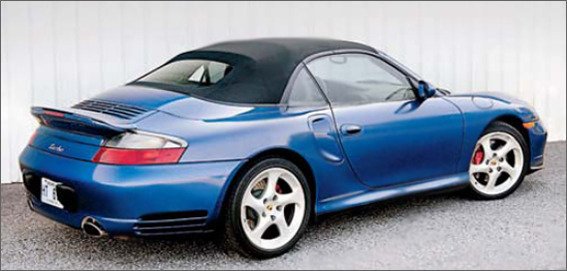
 Short Take Road Test
Short Take Road Test
At first glance, the sports-car faithful will see the automatic Tiptronic transmission in a 911 Turbo cabriolet as an affront to their belief in the sanctity of the clutch pedal. Well, consider this one to be the reformer sports car, unwilling to accept the old doctrine that a fluid-coupling torque converter is a sinful device and three pedals are the only way to nirvana.
The Tiptronic should be viewed as a device that spreads sports-car ecstasy to more people—at least people with $130,665 to spend—and makes it easier for them to understand. It's a philosophy that may upset the faithful, but the puritanical among them used to get upset about roll-up windows, so their beliefs are not exactly rooted in what's practical. If you have an open mind, the automatic Turbo cabriolet is good enough to make you think again.


In light of the company the 911 Turbo cabriolet keeps, an automatic, at least an optional one, makes perfect sense. Tiptronics are in 25 percent of all 911 Turbo cabriolets, but automatic-only roadsters rule the segment. Mercedes-Benz's SL600 and SL55 AMG are automatic only, as is the Cadillac XLR, and even Maserati offers a clutchless Spyder. In this class, buyers seem to want supercar performance that works in even the worst traffic. They are unwilling to live with the bother of using their left leg and right arm. I know, I know, there is serious joy to be had with the perfect heel-and-toe downshift and rowing a perfectly weighted linkage, but the Turbo comes standard with a manual—Tiptronic buyers have to shell out a $3420 penance.


Although we have never tested a 911 Turbo cabriolet with a manual transmission, it would likely not be much quicker than the automatic version. Launching the automatic Turbo from a stop is as easy as holding your left foot on the brake and depressing the accelerator with your right—see, you'll still be able to use both feet. After the revs rise, release the brake and you're gone—no wheelspin, no clutch-destroying high-rpm launches here. Just let the all-wheel drive and the torque converter handle putting the 415 pound-feet of torque to the street. The run to 60 mph is over in a drama-free 3.8 seconds; keep your foot on the throttle and the quarter-mile passes in 12.2 seconds at 116 mph. To put this acceleration in perspective, that's a scant 0.1 second slower in the quarter than the legendary Ferrari F40. This 911 Turbo must have been a particularly healthy example because it was faster than any other 911 Turbo—manual or automatic—we've ever tested.
The droptop Turbo isn't the quickest car in the segment—the SL600 is quicker. But if you're concerned about being outaccelerated by your neighbor's SL600, there's an additional 29 horsepower (bringing the total to 444) to be had with the X50 package. For 2005, Porsche will offer a new Turbo S that will bundle ceramic brake rotors, six-piston calipers, and the horsepower-boosting X50 package for $143,665. That seems steep, but if you had ordered those options in 2004, you would have paid about $13,000 more.
Although the naturally aspirated 911 gets a revised platform with new styling for 2005, the '05 Turbo soldiers on with the existing platform. However, the current platform keeps up easily with the 415 horsepower. Turbocharged 911s have taut chassis, and the Tiptronic car is no exception. The downside of this tuning is the limited suspension travel and attendant harshness that makes all but perfectly paved roads feel as if you'd wandered off-road. The ride is likely too harsh for the Mercedes SL crowd, but the 911 cabrio's body never creaks, groans, or shudders. When pushed, the convertible 911 Turbo never sets a foot wrong. Slow-speed corners reveal some understeer, largely due to the staggered tire sizes and rearward weight distribution. At higher speeds, the tendency to push diminishes, but it's there to keep things safe.


It is expected in this class of car that top operation be effortless. The Turbo doesn't disappoint. Push a single button, and the top unlatches itself and tucks behind the back seat. Raising the roof is just as easy. What makes the Turbo unique is that raising or lowering the top can be done at up to 31 mph. No more holding up traffic at stoplights as you wait for the top to complete its duty.
To fully understand the Tiptronic Turbo cabriolet, it must be viewed as a different animal than the manual Turbo, which is a no-nonsense beast for those who appreciate performance above all else. The Tiptronic car is an SL competitor for those who want something more hard-core but don't revel in shifting. This may sound like heresy to the cult of the three pedals, but an automatic makes its owners happy, and even the most puritanical enthusiast would agree that happiness is what sports cars are all about.